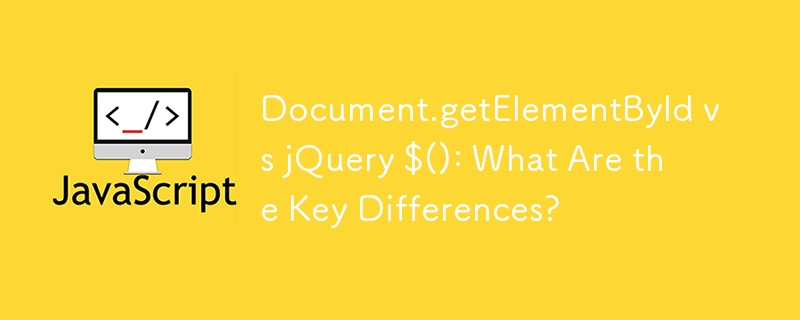Heim >Web-Frontend >js-Tutorial >Document.getElementById vs. jQuery $(): Was sind die Hauptunterschiede?
Document.getElementById vs. jQuery $(): Was sind die Hauptunterschiede?
- Barbara StreisandOriginal
- 2024-10-17 22:20:02901Durchsuche

Document.getElementById vs jQuery $(): A Comparative Analysis
When delving into the realm of web development, understanding the nuances between vanilla JavaScript and jQuery can be crucial. This article examines the subtle differences between two seemingly identical code snippets:
var contents = document.getElementById('contents');
var contents = $('#contents');
Often assumed to be equivalent, their subtle variations can lead to crucial distinctions in their functionality.
Core Differences
- Return Type: document.getElementById('contents') returns an HTML Document Object Model (DOM) object, while $('#contents') returns a jQuery object. jQuery objects possess an array-like structure and support numerous jQuery methods.
- Element Referencing: In jQuery, to access the actual DOM element from a jQuery object, one must specify the index or apply the .get() method, e.g., contents = $('#contents')[0]; or contents = $('#contents').get(0);.
Practical Applications
While both methods serve the same purpose of referencing HTML elements, their variations become apparent in specific scenarios:
- Handling Multiple Elements: jQuery excels in manipulating multiple elements concurrently, e.g., $('.class').hide() hides all elements with the specified class. In contrast, document.querySelectorAll('.class') must be employed to perform a similar task in vanilla JavaScript.
- Cross-Platform Compatibility: jQuery boasts excellent cross-platform compatibility, seamlessly functioning across browsers. document.getElementById, on the other hand, is not guaranteed to work universally.
- Event Handling: jQuery provides an enhanced API for event handling compared to vanilla JavaScript, offering methods like .on(), .toggle(), and .live().
Conclusion
While both document.getElementById and jQuery $() can be used to access elements, their fundamental distinctions in return type and functionality become evident in specific use cases. jQuery's rich API and cross-platform adaptability make it a compelling choice for complex web applications, while vanilla JavaScript remains a viable option for simpler projects.
Das obige ist der detaillierte Inhalt vonDocument.getElementById vs. jQuery $(): Was sind die Hauptunterschiede?. Für weitere Informationen folgen Sie bitte anderen verwandten Artikeln auf der PHP chinesischen Website!
In Verbindung stehende Artikel
Mehr sehen- Eine eingehende Analyse der Bootstrap-Listengruppenkomponente
- Detaillierte Erläuterung des JavaScript-Funktions-Curryings
- Vollständiges Beispiel für die Generierung von JS-Passwörtern und die Erkennung der Stärke (mit Download des Demo-Quellcodes)
- Angularjs integriert WeChat UI (weui)
- Wie man mit JavaScript schnell zwischen traditionellem Chinesisch und vereinfachtem Chinesisch wechselt und wie Websites den Wechsel zwischen vereinfachtem und traditionellem Chinesisch unterstützen – Javascript-Kenntnisse

